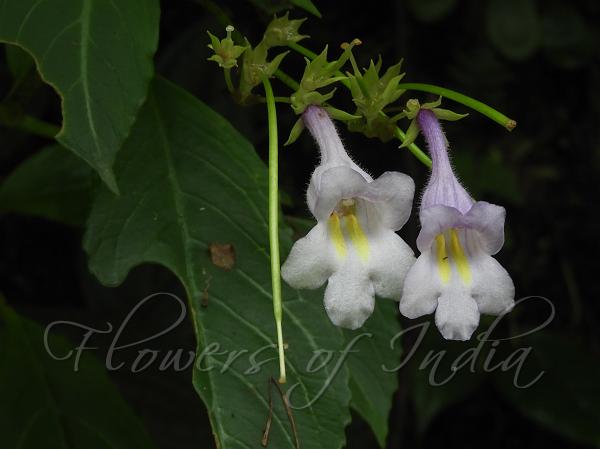|
| Himalayan Lysionotus |
|

|

| File size | 470162 |
| Original date | 8/9/19 12:53 PM |
| Resolution | 5184 x 3888 |
| Flash | Flash did not fire, auto, red-eye reduction |
| Focal length | 39.4mm |
| Exposure time | 1/60s |
| Aperture | 5.3 |
| Focus Distance | |
| Metering Mode | Multi-segment |
| Camera make | NIKON |
| Camera model | COOLPIX B700 |
| Sensor type |
|
|
|
|
Photo: |
Botanical name: Lysionotus serratus Family: Gesneriaceae (Gloxinia family)
Synonyms: Didymocarpus esquirolii, Hemiboea himalayensis, Lysionotus himalayensis
Synonyms: Didymocarpus esquirolii, Hemiboea himalayensis, Lysionotus himalayensis
Himalayan Lysionotus is a subshrub with stems 10-100
cm, hairless. Flowers are purplish to white, 2.5-4.5 cm, outside
sparsely finely velvet-hairy, inside sparsely glandular finely
velvet-hairy basally; tube slender funnel-shaped, 2.2-3 x 0.8-1 cm;
upper lip about 4 mm; lower lip 8-10 mm. Stamens 0.8-1.2 mm. Sepal-cup
5-parted from base; sepals 4-8 x 1.5-4 mm, hairless. Flowers are borne
in 3-15-flowered cymes, carried on flower-cluster-stalk 3.5-10 cm long,
bracts ovate to round, 3.5-10 x 4-8.5 mm. Flower-stalks are 3-11 mm.
Leaf-stalks are 1-16 mm; leaf blade elliptic to lanceshaped, ovate, or
obovate, 4-14 x 2-4.8 cm, herbaceous, seldom papery, hairless, base
wedge-shaped to rounded, margin toothed to sawtoothed or crenulate, tip
tapering to blunt; lateral veins 5-8 on each side of midrib, flat to
prominent. Capsules are 7-11 cm. Seed appendages hairlike, 1-1.2 mm.
Himalayan Lysionotus grows on the ground, on trees or rocks in forests,
streamsides, grassy slopes, valleys from Himalaya to China, at
altitudes of 300-2800 m. Flowering: July-September.
| Identification credit: Momang Taram | Photographed in Papum Pare, Arunachal Pradesh. |
• Is this flower misidentified? If yes,